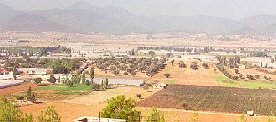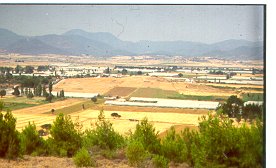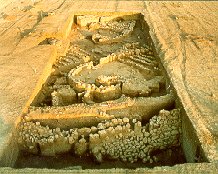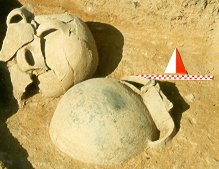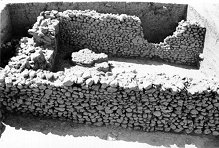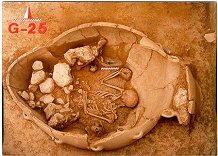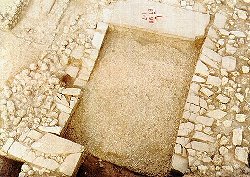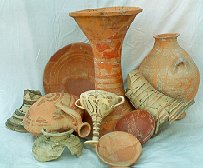![]()

![]()
BAKLA TEPE is situated on a rocky hill at the northern end of the Bulgurca village near Menderes - Izmir. Excavation of the site is continuing as a joint rescue Project together with the IRERP and the Izmir Museum under the scientific direction of Prof. Dr. Hayat Erkanal (Ankara University). The site reflects a cultural sequence starting from Late Chalcolithic and continuing into the Early Bronze Age I period. The site expands over an area 250m in diameter during the L.Chal. period, but is reduced in size in the following EBA I period.
|
|
|
|
A General View of Bakla Tepe. On the Left, the site before the clearing of trees. On the Right, the site after the olive grove was cleared due to the approaching water of the dam. |
|
Late Chalcolithic Period
|
|
|
|
The remains at Bakla Tepe reflect an agricultural community with grill-planned (Left), apsidal and round houses of wattle-and-daub construction during the Late Chalcolithic period. A "Kumtepe type" ceramic sequence of at least four main phases has been identified so far. Large number of infant burials (Right) have been unearthed under the floors of the structures while signs of an extramural cemetery of adult burials have been encountered to the east of the Late Chalcolithic settlement. |
|
|
Late Chalcolithic settlement yielded important amounts of metal finds and slags indicating the existance of a developed metal production at this early stage on the site. Lithic (obsidian and silex) and bone artifacts attested at the Late Chalcolithic village are also abundant. Large deposits of carbonized grains from stratified contexts leads us to a preliminary conclusion that an organized agricultural behaviour was present at the site during the Late Chalcolithic Period. "Cheesepots", a well known vessel form in the insular Aegean is another artifact that characterises the Late Chalcolithic community of Bakla Tepe. This find group will also help to create chronological synchronisms with the rest of the Aegean. |
|
Early Bronze Age I
|
|
The EBA I settlenment of Bakla Tepe yielded remains of multiple building complexes of "long houses". These architectural features are surrounded with a defense system. Signs of a possible ditch has been uncovered at the end of the 1997 season and more investigations will be carried out in the final - 1998 - season of the excavations at Bakla Tepe. |
|
The extramural cemetery of the EBA I settlement has been located just outside the defense system of the settlement. The cemetery consists of pithos, simple pit burials and stone cist graves. |
|
Late Bronze Age
|
|
|
|
A rectangular chamber tomb of Mycenaeo-Anatolian character (Left) was unearthed on top of the mound, just 5cms below the surface level. The tomb was found intact except for a destruction in ancient times. Large numbers of imported and local painted Mycenaen wares (Right) including stemmed bowls, kylixes, alabastrons, and stands were found along with local plain wares. Lots of decorated ivory, glass and paste beads and inlays, have been found within the tomb. Metal finds include gold and bronze objects. The tomb dates to the 13th Century B.C. |
|

1998 most probably will be the last season at Bakla Tepe where extensive excavations can take place due to the high water level. The mound has recently been surrounded by the dam lake and access to the mound is possible only from one direction. The nearby Bulgurca village is already underwater. Click here to see the latest views from Bakla Tepe, taken during the second week of April.
©
IRERP Last updated on Wednesday, May 10 2000.
This page is hosted by GeoCities
